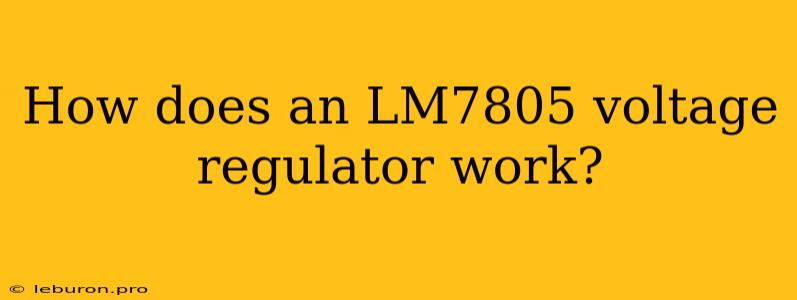The LM7805 is a ubiquitous and versatile integrated circuit (IC) that serves as a voltage regulator, specifically designed to provide a stable and regulated 5V output voltage. Its widespread use in electronic circuits stems from its ability to effectively convert unregulated DC voltage into a reliable 5V supply, crucial for powering various components like microcontrollers, op-amps, and logic circuits. This article delves into the inner workings of the LM7805, examining its internal circuitry and the principles that govern its voltage regulation function.
Understanding the LM7805's Architecture
At its core, the LM7805 is a linear voltage regulator based on a series pass transistor configuration. This architecture utilizes a transistor, often a power BJT, to control the output voltage by adjusting its current flow. The key components within the IC, besides the pass transistor, include a reference voltage source, an error amplifier, and an output current limiting circuit.
Reference Voltage
The reference voltage source generates a stable and accurate 5V reference voltage. This voltage serves as the benchmark against which the output voltage is compared. The reference voltage is crucial for establishing the precise 5V output regulation.
Error Amplifier
The error amplifier is a differential amplifier that compares the output voltage with the reference voltage. Any difference between these two voltages, termed as the error voltage, is amplified by the error amplifier. The amplified error voltage is then used to control the base current of the pass transistor.
Pass Transistor
The pass transistor is a power BJT that acts as a variable resistor. By adjusting the base current, the pass transistor regulates the current flow from the input to the output. If the output voltage drops below the reference voltage, the error amplifier increases the base current of the pass transistor, increasing its conduction and raising the output voltage. Conversely, if the output voltage rises above the reference voltage, the error amplifier decreases the base current, reducing conduction and lowering the output voltage.
Operational Principles
The LM7805 voltage regulation process involves a feedback mechanism that continuously monitors and adjusts the output voltage to maintain it at 5V. The core principle is based on the error amplifier's response to deviations in the output voltage.
- Input Voltage: An unregulated DC voltage, typically higher than 5V, is applied to the input pin of the LM7805.
- Reference Voltage Comparison: The error amplifier compares the output voltage with the internal 5V reference voltage.
- Error Voltage Amplification: Any difference between the output and reference voltage generates an error voltage, which is amplified by the error amplifier.
- Pass Transistor Control: The amplified error voltage controls the base current of the pass transistor.
- Output Voltage Adjustment: The pass transistor adjusts its conduction based on the amplified error voltage. If the output voltage is lower than 5V, the pass transistor conducts more, raising the output voltage. If the output voltage is higher than 5V, the pass transistor conducts less, lowering the output voltage.
- Stabilization: This continuous feedback loop ensures that the output voltage remains at 5V, even with variations in the input voltage or load current.
Key Features and Considerations
The LM7805 possesses several notable features:
- Fixed Output Voltage: The LM7805 provides a fixed output voltage of 5V, making it ideal for applications requiring a precise 5V supply.
- Current Limiting: The internal circuitry limits the output current to prevent excessive load on the regulator, safeguarding the device from damage.
- Thermal Protection: The LM7805 includes thermal protection circuitry to prevent overheating during heavy load conditions.
- Low Dropout Voltage: The LM7805 can operate with a relatively low input-output voltage difference, making it suitable for applications with limited voltage headroom.
- Wide Input Voltage Range: The LM7805 can typically handle input voltages from 7V to 35V, depending on the specific device variant.
Applications of the LM7805
The LM7805 finds widespread application in various electronic circuits, including:
- Powering Microcontrollers: The 5V output provides a stable and reliable power supply for microcontrollers, enabling their operation.
- Op-Amp Circuits: Op-amp circuits often require a regulated 5V supply for proper functioning.
- Logic Circuits: Logic gates and other digital circuits rely on a stable 5V power source for reliable operation.
- Sensors and Transducers: Many sensors and transducers operate at 5V, utilizing the LM7805 for a regulated power source.
- Hobbyist Projects: The LM7805 is a popular choice for hobbyists and makers due to its simplicity and versatility.
Conclusion
The LM7805 voltage regulator is a fundamental component in electronic circuits, providing a stable and reliable 5V output voltage. Its simple architecture, featuring a reference voltage source, error amplifier, and pass transistor, enables accurate voltage regulation through a feedback mechanism. The LM7805's ease of use, versatility, and affordability make it a staple for a wide range of applications, from hobbyist projects to professional electronic designs. Understanding its operation allows engineers and hobbyists to effectively utilize this crucial component to ensure the reliable operation of their circuits.
